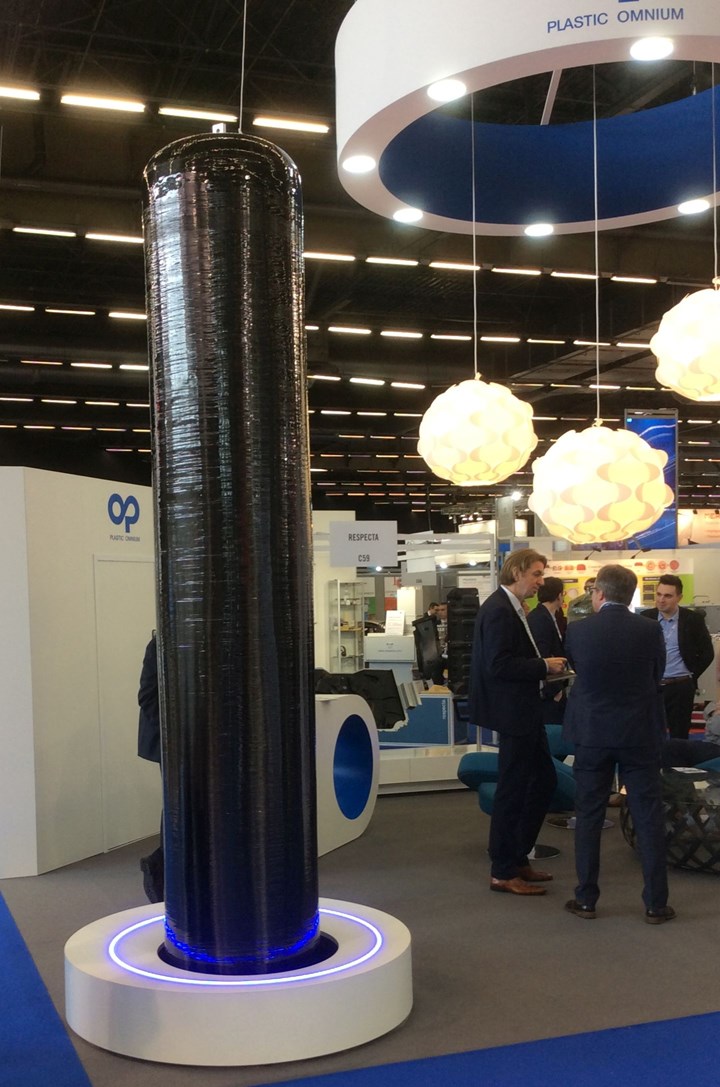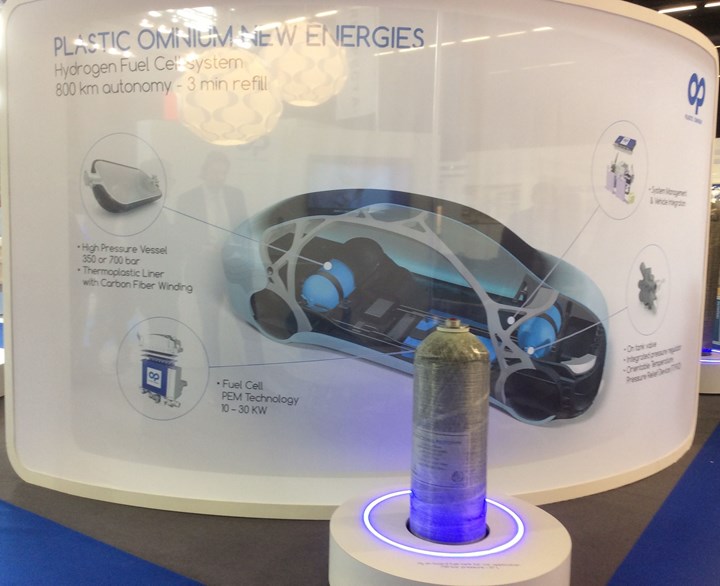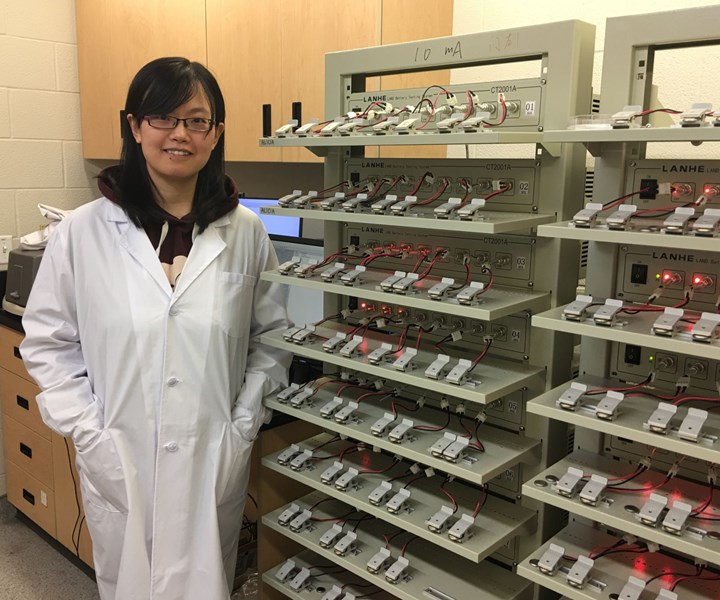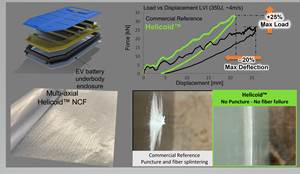CompositesWorld News for Dec. 02, 2019
Read news from Evonik, and 3M Engineered Products and Solutions
Evonik expands U.S. production capacity for ROHACELL foams
The expansion includes a new production hall and is scheduled for completion in the fourth quarter of 2020.

ROHACELL foam forms the core of lightweight sandwich structures with high shear strength and compressive strength, even at relatively high temperatures. Source | Evonik
Due to increasing demand for lightweight construction materials for specialty applications, Evonik (Hopewell, Va., U.S.) is expanding its production of ROHACELL high-performance rigid, closed-cell foams at its Mobile, Alabama site in the United States. The production expansion is scheduled to be completed by the fourth quarter of 2020. The expansion of ROHACELL production in Mobile includes construction of an additional production hall, and all shipping logistics will be combined in the new facility.
With this investment, the company says it will significantly increase production capacity for high-temperature resistant polymethacrylimide (PMI) foams in North America.
“The investment in Mobile strengthens our global position as a reliable partner and solutions provider of high-performance, lightweight PMI-based rigid foams and enables us to meet increasing demand in North America over the long term,” says Christina Walkosak, head of the High Performance Polymers business line, Americas, for Evonik.
Evonik’s Mobile, Ala., U.S. PMI foam plant first opened in November 2008.
“For many years now, we have been seeing consistently high global demand for our high-performance foams, particularly from the aerospace industry and the electronics market, and we are responding to the marketplace by expanding our production capacity accordingly,” says Walkosak. Two years ago Evonik stepped up its ROHACELL production in Germany by 20%. “Now we’ll be significantly increasing our output in North America to be able to support our customers’ growth appropriately.”
ROHACELL, a rigid structural foam of polymethacrylimide, is used in the design and production of sandwich structures in aviation, cars, ships, sports goods, electronics and medical technology. The lightweight foam withstands high temperatures and pressures, making it a suitable core material solution for composite structures.
Plastic Omnium confirms its position in CFRP hydrogen storage tanks
Contract for 350-bar bus tanks and certification for 700-bar passenger car tanks recognize developed technology and strategy for growing global hydrogen/fuel cell ecosystem.

SOURCE | Plastic Omnium
Plastic Omnium (Levallois, France) has recently won a significant order from a German manufacturer for the development of 350-bar hydrogen tanks. The contract signed for bus equipment is the largest project in Europe at this time for this type of vehicle.
In parallel to this success, Plastic Omnium has just obtained its first certification for a 700-bar hydrogen storage tank designed to equip passenger cars. The R134 certification is an international standard comprising the strictest specifications for the regulation of high-pressure hydrogen tanks. Other certifications are underway for 350-bar hydrogen tanks and for CNG (compressed natural gas) tanks.
Plastic Omnium reports that this contract and first certification demonstrate the recognition of its technological know-how, developed in the field of high-pressure composite plastic tanks over the last four years. In 2016, the company formed PO-Celltech (Caesarea, Israel) with Elbit Systems, drawing on its decades of leadership in advanced electronics to develop novel technology for low-cost, mass-produced fuel cells and supercapacitors for automotive. Then in 2017, Plastic Omnium acquired Optimum CPV (Zonhoven, Belgium), a specialist in filament wound composite high-pressure hydrogen storage tanks, and Swiss Hydrogen (Fribourg, Switzerland) which produces solutions for the management and control of energy in fuel cell systems.


Plastic Omnium displayed multiple carbon fiber filament wound hydrogen storage tanks at JEC 2018. SOURCE | CW
Plastic Omnium’s hydrogen strategy has recently been reinforced by the opening of two R&D centers, Δ-Deltatech in Brussels and ω-Omegatech in Wuhan, China, where a pilot carbon filament winding line has recently been inaugurated. In 2020, Plastic Omnium will also install a dedicated hydrogen tank production line at its Herentals, Belgium fuel tank plant. In addition, its investment in AP Ventures, a venture capital fund based in London and dedicated solely to hydrogen, reportedly provides Plastic Omnium with opportunities and interesting choices for the future.
As a global leader in fuel and emissions control systems, Plastic Omnium is thus confirming its position as a major player in the clean mobility market and the emerging landscape for carbon fiber composite pressure vessels.
Graphene Council partners with SAE International
The organizations will partner to share information on graphene and transportation advances and challenges, and will present their results at two events next year.

The Graphene Council, a global trade and professional association for producers, users and researchers of graphene, has announced a partnership with SAE International, a global association committed to advancing mobility knowledge and solutions. The partnership will enable SAE to provide its members with up-to-date information about commercially available forms of graphene and how to apply this novel material to solve technical challenges. SAE will help the members of The Graphene Council to better understand the engineering challenges and requirements impacting the development of the leading transportation systems of tomorrow.
The organizations will present the results of the project at eventAeroTech SAE’s on March 17-19, 2020, in Pasadena Calif., U.S., and SAE’s WCX World Congress Experience 2020, on April 21-23, 2020, in Detroit.
“This partnership will help accelerate the development of important solutions in some of the most critical sectors of our modern society, aerospace and land based transportation. Graphene has already demonstrated the ability to impart strength and reduce weight in composites, enable extremely small and highly responsive sensors, and has proven the ability to dramatically improve battery technology, just to name a few key areas,” says Terrance Barkan CAE, executive director of The Graphene Council.
“SAE International strives to provide our members and partners with the latest information, including the ability to identify and understand innovative new materials that enable the development of next level solutions. Our partnership with The Graphene Council provides access and understanding to one of the most disruptive new materials,” says Dave Weil, director of events for SAE International.
Graphene is defined as a single layer of carbon atoms arranged in a plane with a hexagonal (“chickenwire”) structure with the carbon atoms sharing a sp2-bond. The result is a material with properties that includes some of the highest ratings for strength, electrical conductivity, thermal conductivity and other valuable properties. Graphene has been demonstrated to have useful properties in an extremely wide range of applications that includes plastics, composites, coatings, energy storage, sensors, electronics, EMI shielding and others that may have direct relevance for SAE members.
Planning application submitted for National Manufacturing Institute Scotland
The NMIS will be an industry-led international center of manufacturing expertise led by Scottish leaders and the University of Strathclyde.

Source | University of Strathclyde Glasgow
A planning application has been submitted for the development of the National Manufacturing Institute Scotland (NMIS) situated at the center of the Advanced Manufacturing Innovation District Scotland (AMIDS) in Renfrewshire.
NMIS will be a £65 million, industry-led international center of manufacturing expertise led by the Scottish government in partnership with the University of Strathclyde and Renfrewshire Council. Operated by Strathclyde, as a national facility for Scotland, the goal of NMIS is to be a place where research, industry and the public sector work together to transform skills, productivity and innovation to attract investment and make Scotland a global leader in advanced manufacturing.
The new, energy carbon neutral, facility next to Glasgow Airport will include a skills academy, a fully digitalized factory of the future and a collaboration hub for manufacturers to work together with research partners and the public sector to innovate and grow their businesses.
NMIS also includes two specialist technology centers: the Lightweight Manufacturing Centre (LMC), which was opened earlier this year by the First Minister; and Strathclyde’s Advanced Forming Research Centre, which is the only High Value Manufacturing Catapult center in Scotland. Iain Bomphray, previous of Williams Advanced Engineering, is now director of the LMC.
The application for NMIS will now be considered by Renfrewshire Council.
NMIS and the Medicines Manufacturing Innovation Centre, in which Strathclyde is lead research partner, will be the anchor institutions in the advanced manufacturing district. The district is benefiting from a £39 million investment to provide the enabling infrastructure, funded through the Glasgow City Region City Deal. It is also home to the NMIS specialist technology centers.
Glasgow-based HLM Architects is leading the NMIS design team, which also includes Waterman Civil & Structural Engineers, Davie + McCulloch Building Services Engineers and Robinson Low Francis LLP Cost Mangers. HLM will also be providing landscape architecture and interior design services, while Turner and Townsend have been appointed as Project Managers under Strathclyde’s Framework Agreement.
“Manufacturing is crucial to our economy and is a sector we want to see flourish in Scotland. This is a notable milestone for the NMIS facility and given the importance of responding to the global climate emergency, I am particularly pleased the facility will be energy carbon neutral and it is great that the facility will lead by example and demonstrate what is possible,” says Economy Secretary Derek Mackay. “NMIS will deliver benefits for businesses across Scotland well before the building is complete including through the existing capability available at the Lightweight Manufacturing Centre which adds to the wider support available from our enterprise agencies to help companies improve their productivity.”
“Scotland has a vibrant manufacturing sector which is well placed for further innovation and growth. To achieve its fullest potential, it needs advanced facilities, resources and equipment, for use by highly qualified and skilled staff; NMIS will offer all of this. At Strathclyde, we have the drive, expertise and track record to support this highly collaborative venture and, with the NMIS partners, support the transformation of Scottish manufacturing,” says Professor Sir Jim McDonald, Strathclyde’s principal.
Graphene used to extend rechargeable battery life
Researchers from Western University finds that adding a carbon-based graphene layer extends lithium-ion rechargeable battery life up to 50%.

Xia Li, Mitacs Postdoc Fellow in Western’s Faculty of Engineering Source | Western Universityh
Researchers from Western University (London, Ontario, Canada), using the Canadian Light Source (CLS) — a synchotron powered light source — at the University of Saskatchewan (Saskatoon, Saskatchewan, Canada), has found that adding a carbon-based layer to lithium-ion rechargeable batteries extends their life up to 50%.
Aluminum foil is commonly used on the cathode as current collector where electricity leaves the battery of rechargeable lithium-ion batteries. This foil has high electronic conductivity and is lightweight and low cost, but the new generation of batteries brings new challenges to the current collectors, which will need even more chemical stability to protect against the corrosion of electrolyte in the cathode. Rather than find an entirely new material for cathodes, the Western team tested a super-thin carbon coating, also known as graphene, produced by 3M Canada (London, Ontario, Canada).
“We added a thin layer of carbon coating to the aluminum foil that conducts electric current in rechargeable batteries,” says Xia Li, a Mitacs postdoc fellow in Western’s Faculty of Engineering and lead researcher of the study. “It was a small change, but we found the carbon coating protected the aluminum foil from corrosion of electrolyte in both high voltage and high energy environments — boosting the battery capacities up to 50% more than batteries without the carbon coating.”
In addition to the graphene coating, 3M Canada supplied the CLS, which uses extremely bright X-rays to identify the chemical changes occuring on delicate battery surfaces as they are operating. Analysis showed that the carbon-based coating is effective in both high-voltage and high-energy environments, which would be important for applications like electric vehicles.
Related Content
Protecting EV motors more efficiently
Motors for electric vehicles are expected to benefit from Trelleborg’s thermoplastic composite rotor sleeve design, which advances materials and processes to produce a lightweight, energy-efficient component.
Read MoreHelicoid Industries releases three use cases of Helicoid technology
Use case applications with Helicoid technology implementation demonstrated mechanical performance improvements, such as impact resistance and strength.
Read MorePrice, performance, protection: EV battery enclosures, Part 1
Composite technologies are growing in use as suppliers continue efforts to meet more demanding requirements for EV battery enclosures.
Read MoreOpportunities and challenges for composites in electric vehicles
Polymer and material specialists at chemical consulting firm ChemBizR reflect on the role of composites in current and future efforts to make electric vehicles more efficient — and more attractive for consumers.
Read MoreRead Next
From the CW Archives: The tale of the thermoplastic cryotank
In 2006, guest columnist Bob Hartunian related the story of his efforts two decades prior, while at McDonnell Douglas, to develop a thermoplastic composite crytank for hydrogen storage. He learned a lot of lessons.
Read MoreCW’s 2024 Top Shops survey offers new approach to benchmarking
Respondents that complete the survey by April 30, 2024, have the chance to be recognized as an honoree.
Read MoreComposites end markets: Energy (2024)
Composites are used widely in oil/gas, wind and other renewable energy applications. Despite market challenges, growth potential and innovation for composites continue.
Read More



























